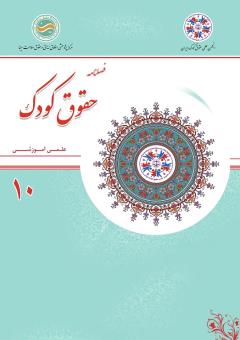کودک همسری: رویکردی پدیدار شناسانه
محورهای موضوعی : حقوق کودک
نرگس پورطالب
1
![]() ,
سیده بهناز موسویان النجق
2
,
سیده بهناز موسویان النجق
2
![]()
1 - گروه روانشناسی، مؤسسه آموزش عالی رشدیه، تبریز، ایران
2 - دانشکده روانشناسی و علوم تربیتی، دانشگاه علامه طباطبایی، تهران، ایران
کلید واژه: ازدواج, همسر, کودک همسری,
چکیده مقاله :
زمینه و هدف: کودک همسری از جمله موضوعات حساس و قابل بحث در حوزه علوم انسانی در دنیای امروز است که به صورت موضوع بین رشته ای قابل بررسی است. پژوهش های کیفی که بتواند این پدیده را عمیقاً و از ابعاد مختلف مورد بررسی قرار دهد، اندک است. از این جهت، پژوهش حاضر با هدف بررسی پدیدارشناسانه کودک همسری انجام گرفت. روش: این تحقیق از نوع پژوهش های کیفی و مبتنی بر رویکرد پدیدارشناسی است. اطلاعات با استفاده از مصاحبه های نیمه ساختاریافته و از 15 نفر از اقشار مختلف جامعه گردآوری شد. برای تجزیه و تحلیل داده ها از روش پدیدار شناسی اسمیت استفاده شد که طی آن 4 مضمون اصلی و 26 مضمون فرعی از داده ها استخراج گردید. یافتهها: نتایج نشان داد که در برخی مضامین فرعی نظیر تعریف، پیامدها و علل کودک همسری، بین تجربیات زیسته افراد با پیشینه تا حدودی همسویی وجود دارد؛ ولی در راهکارهای ارائه شده نتایج متفاوتی دیده می شود. نتیجهگیری: افراد بنا به ترجیحات شخصی خود راهکارهای مختلفی برای والدین و جامعه و خود جوانان در حوزه رفع چالش های کودک همسری پیشنهاد کرده اند. در این میان توجه به شرایط بومی، استفاده از ابزار فرهنگ سازی و وجود سازوکار رسمی برای اهمیت دهی به رضایت افراد در ازدواج جایگاه مهمی دارد. نتایج حاصل از این پژوهش راهگشای تحقیقات بیشتر در حوزه مسائل مربوط به ازدواج و اثرات فردی و اجتماعی آن خواهد بود.
Background and Aim: Child marriage is one of the controversial issues in the field of humanities that can be studied as interdisciplinary subject. Few qualitative studies have investigated this problem. Therefore, this study was performed to investigate child marriage. Method: This is a qualitative study with a phenomenological approach. In this study, 15 numbers from different sectors of the society were selected. Data was collected by using semi – structured interviews and analyzed using Smith method. After data analyze, 4 main themes and 26 sub-themes were extracted. Results: It was revealed that in some sub-themes such as definition of child marriage, consequences and causes, there was a consistency between individuals lived experiences and background. But in feedbacks different results were obtained. Individuals based on their personal preferences, propose different methods for parents, society and youngsters. The results of this study will pave the way for further research on the interventions related to child marriage. Conclusion: Individuals based on their personal preferences, propose different methods for parents, society and youngsters. Among these, paying attention to the local conditions, using the platform of culture and the existence of an official mechanism to give importance to the satisfaction of people in marriage has an important place. The results of this study will pave the way for further research on the interventions related to child marriage.
1. Farahmand M. Danafar F, Pourebrahimabadi M. Analyzing the marital experiences of children in marriage: emotional-intellectual confusion and powerlessness. Bi-quarterly journal of contemporary sociological researches. 2020; 9(17), 115-145. [Persian]
2. Zamani R, Saberian A, Rouhani Maghaddam M. Marriage Age and Its Status in International Instruments. MLJ. 2019; 13 :353-365. [Persian]
3. Eftekharzadeh Z. Lived Experiences of Female Victims of Child Marriage. Social work research paper. 2015; 2(3): 111-155. [Persian]
4. Beyabanagard A. Educational Psychology. Tehran: Virayesh Publisher; 2015. [Persian]
5. John NA, Edmeades J, Murithi L, Barre I. Child marriage and relationship quality in Ethiopia. Culture, Health & Sexuality. 2019; 21(8): 853-866.
6. Ahmadi K. Resonance of Silence: a comprehensive research on Child Marriage in Iran. Shiraz; 2017. [Persian]
7. Meghdadi M M, Javadpour M. Impact of Early Marriage on Children's Sexual Health and Mechanisms of Deal with It. MLJ. 2017; 11(40): 31-60. [Persian]
8. Landini C. Child Marrage in The Context Of COVD-19. UNICEF; 2021, p. 2-32.
9. Ahadi arson K. Study of the experiences of high school teachers in Tabriz from continuous evaluation in 2011-2012 [dissertation]. Tabriz university; 2014. [Persian]
10. Hosseini Pouya M. Child Marriage (Message from the Responsible Director). The internal quarterly of the Bar Association. 2017; 17: 11-16.
11. Imanzadeh A. Alipour S. The lived experience of women in Marand from the problems of early marriage. Women and culture scientific research quarterly. 2015; 8(30): 31-46. [Persian]
12. Asghari S. Early Marriage in Iran: A Pragmatic Approach. Journal of Human Rights Practice. 2019; 11: 569-588. [Persian]
13. Siah Bidi Kermanshahi S. Bahram Puri R, Koohestani M. Jurisprudential analysis of child marriage in the light of criticisms on it; An attempt to provide a favorable offer. Scientific, cultural and educational journal of women and family. 2019; 15(52): 149-165. [Persian]


